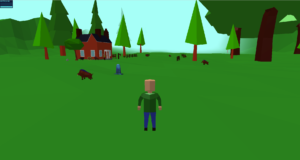I have updated the object loading code so that if an FBX contains a mesh called “Collider” that that mesh gets added to the collider list. This way I can add collider meshes in Blender, export the new object, and when it gets added into the world the collider mesh is included, so that’s neat. I created a collider mesh for the fence sections and one of the tree types.
This is mostly working but, again, I noticed that it’s not perfect. On the fence collider sliding down some of the faces isn’t perfect. It just sort of hangs up here and there. Also, the tree collider gives me some of the same issues that my test sphere was having, specifically the browser crashed at one point. This shouldn’t be surprising since I can’t really say I understand the collision system all that well, but hopefully now that it’s organized I can go through and optimize it and really gain a full understanding of what’s happening. Even with these nagging issues, I’m still really excited that creating collider meshes for objects in the world looks like it should be pretty easy.
